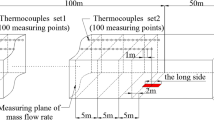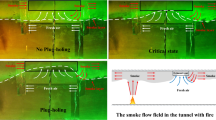Abstract
This paper studied the effect of lateral smoke extraction on the transverse temperature distribution and maximum smoke temperature beneath the ceiling. The experiments were conducted in a reduced model tunnel (1:8). In the experimental study of optimal aspect ratio of the smoke extraction vent, a series of experimental conditions were considered. Keeping the same area of vents, four kind aspect ratios were set (n = 1, 2, 3, and 4). In experiment investigation of ceiling maximum smoke temperature, under the best vent aspect ratio n = 3, four fire heat release (50 kW, 60 kW, 70 kW, and 80 kW) rates were considered. The experimental results showed that the lateral smoke extraction system will affect the transverse temperature distribution, the transverse temperature distribution curve shows good stratification phenomenon, and the maximum temperature point will offset to the direction of the lateral extraction vent. The data of the maximum temperature under different test conditions were analyzed, and the influence factors of lateral smoke extraction were considered. Finally, the correlation of the maximum smoke temperature under the influence of lateral smoke extraction was proposed.










Similar content being viewed by others
Abbreviations
- \(c_{{\text{p}}}\) :
-
Air specific heat capacity (kJ (kg K)−1)
- \(g\) :
-
Acceleration of gravity (m s−2)
- \(H_{{{\text{vent}}}}\) :
-
Height of lateral smoke extraction vent (m)
- \(H_{{\text{d}}}\) :
-
Distance between burner surface and tunnel ceiling (m)
- \(\Delta \dot{m}\) :
-
Mass flow of lateral smoke extraction (kg s−1)
- \(n\) :
-
Aspect ratio of lateral smoke extraction vent
- \(\dot{Q}\) :
-
Fire heat release rate (kW)
- \(\dot{Q}_{{\text{a}}}\) :
-
Actual fire heat release rate for lateral smoke extraction (kW)
- \(\dot{Q}_{{\text{c}}}\) :
-
Convective heat release rate (kW)
- \(r\) :
-
Radius of the fire source (m)
- \(S\) :
-
Area of the lateral smoke extraction vent (m2)
- \(T\) :
-
Ceiling smoke temperature (K)
- \(T_{{\text{a}}}\) :
-
Ambient temperature (K)
- \(\Delta T_{\max }\) :
-
Ceiling maximum temperature rise (K)
- \(\Delta T_{{{\text{vent}}}}\) :
-
Smoke temperature rise near lateral smoke extraction vent (K)
- \(V\) :
-
Longitudinal ventilation velocity (m s−1)
- \(V^{*}\) :
-
Dimensionless longitudinal ventilation velocity
- \(V^{^{\prime}}\) :
-
Characteristic plume velocity (m s−1)
- \(v^{*}\) :
-
Dimensionless lateral smoke extraction velocity
- \(v\) :
-
Lateral smoke extraction velocity (m s−1)
- \(W_{{{\text{vent}}}}\) :
-
Width of lateral smoke extraction vent (m)
- \(\rho\) :
-
Smoke density (kg m−3)
- \(\rho_{{\text{a}}}\) :
-
Ambient air density (kg m−3)
- \(\Delta \rho\) :
-
Difference between the density of smoke and ambient air (kg m−3)
- \(F\) :
-
Full scale
- \(M\) :
-
Model scale
References
Chow WK, Gao Y, Zhao JH, Dang JF, Chow NCL. A study on tilted tunnel fire under natural ventilation. Fire Saf J. 2016;81:44–57.
Chen L, Tang F. Experimental study on the longitudinal temperature decay beneath ceiling in ventilated tunnel fires. J Therm Anal Calorim. 2019;139(5):3179–84.
Zhao WF, Zong RW, Fan XL, Zhao XJ, Deng YL, Zhang XY. Scaling applications of wall parameters in a tunnel fire. Tunn Undergr Sp Technol. 2021;106:103585.
Fan CG, Yang J, Li MH. A theoretical and experimental study of flame length under a tunnel ceiling. J Therm Anal Calorim. 2016;128(2):1143–9.
Chen X, Lu S, Ding Z. Initial fuel depth effect on the burning characteristics of thin-layer pool fire in a confined enclosure. J Therm Anal Calorim. 2019;139(2):1409–18.
Zhang S, Ni X, Zhao M, Feng J, Zhang R. Numerical simulation of wood crib fire behavior in a confined space using cone calorimeter data. J Therm Anal Calorim. 2014;119(3):2291–303.
Shi CL, Zhong MH, Chen CK, Jiao WB, Li J, Zhang YL, Zhang L, Li Y, He L. Metro train carriage combustion behaviors–Full-scale experiment study. Tunn Undergr Sp Technol. 2020;104:103544.
Hajra B, Stathopoulos T, Bahloul A. A wind tunnel study of the effects of adjacent buildings on near-field pollutant dispersion from rooftop emissions in an urban environment. J Wind Eng Ind Aerodyn. 2013;119:133–45.
Zhang S, Ni X, Zhao M, Zhang R, Zhang H. Experimental study on the characteristics of wood crib fire in a confined space with different ventilation conditions. J Therm Anal Calorim. 2015;120(2):1383–91.
Yang D, Huo R, Zhang XL, Zhu S, Zhao XY. Comparative study on carbon monoxide stratification and thermal stratification in a horizontal channel fire. Build Environ. 2012;49:1–8.
Liang Q, Li Y, Li J, Xu H, Li K. Numerical studies on the smoke control by water mist screens with transverse ventilation in tunnel fires. Tunn Undergr Sp Technol. 2017;64:177–83.
Tang F, Li LJ, Dong MS, Wang Q, Hu LH. Characterization of buoyant flow stratification behaviors by Richardson (Froude) number in a tunnel fire with complex combination of longitudinal ventilation and ceiling extraction. Appl Therm Eng. 2017;110:1021–8.
Tang F, Hu LH, Yang LZ, Qiu ZW, Zhang XC. Longitudinal distributions of CO concentration and temperature in buoyant tunnel fire smoke flow in a reduced pressure atmosphere with lower air entrainment at high altitude. Int J Heat Mass Transf. 2014;75:130–4.
Zhou T, He Y, Lin X, Wang X, Wang J. Influence of constraint effect of sidewall on maximum smoke temperature distribution under a tunnel ceiling. Appl Therm Eng. 2017;112:932–41.
Wei T, Zhao W, Zong R. Analytical study of wall factor on the ceiling temperature distribution in the far field for tunnel fires. J Wind Eng Ind Aerodyn. 2017;171:196–201.
Gannouni S, Ben MR. Numerical analysis of smoke dispersion against the wind in a tunnel fire. J Wind Eng Ind Aerodyn. 2016;158:61–8.
Tao Z, Yang R, Li C, Yao Y, Zhu P, Zhang H. Experimental study on liquid fire behavior at different effective ceiling heights in a full-size simulated cargo compartment. J Therm Anal Calorim. 2018;133(3):1617–26.
Li HH, Liu HQ, Liu JH, Ge JW, Tang F. Spread and burning characteristics of continuous spill fires in a tunnel. Tunn Undergr Sp Technol. 2021;109:103754.
Migoya E, Garcia J, Crespo A, Gago C, Rubio A. Determination of the heat release rate inside operational road tunnels by comparison with CFD calculations. Tunn Undergr Sp Technol. 2011;26(1):211–22.
Tang F, Cao ZL, Palacios A, Wang Q. A study on the maximum temperature of ceiling jet induced by rectangular-source fires in a tunnel using ceiling smoke extraction. Int J Therm Sci. 2018;127:329–34.
Li YZ, Lei B, Ingason H (2010) Study of critical velocity and backlayering length in longitudinally ventilated tunnel fires. Fire Saf J. 45(6–8):361–370.
Yang SC, Chuah YK. A study of wind effects on smoke extraction strategies in vehicle tunnels. Tunn Undergr Sp Technol. 2017;67:8–26.
Zhu YT, Tang F, Chen L, Wang Q, Xu XM. Effect of lateral concentrated smoke extraction on the smoke back-layering length and critical velocity in a longitudinal ventilation tunnel. J Wind Eng Ind Aerod. 2020;207:104403.
Wang YF, Li YL, Yan PN, Zhang B, Jiang JC, Zhang L. Maximum temperature of smoke beneath ceiling in tunnel fire with vertical shafts. Tunn Undergr Sp Technol. 2015;50:189–98.
Mei FZ, Tang F, Ling X, Yu JS. Evolution characteristics of fire smoke layer thickness in a mechanical ventilation tunnel with multiple point extraction. Appl Therm Eng. 2017;111:248–56.
Hu LH, Tang W, Chen LF, Yi L. A non-dimensional global correlation of maximum gas temperature beneath ceiling with different blockage–fire distance in a longitudinal ventilated tunnel. Appl Therm Eng. 2013;56(1–2):77–82.
Tang F, Cao ZL, Chen Q, Meng N, Wang Q, Fan CG. Effect of blockage-heat source distance on maximum temperature of buoyancy-induced smoke flow beneath ceiling in a longitudinal ventilated tunnel. Int J Heat Mass Transf. 2017;109:683–8.
Chow WK, Wong KY, Chung WY. Longitudinal ventilation for smoke control in a tilted tunnel by scale modeling. Tunn Undergr Sp Technol. 2010;25(2):122–8.
Huo Y, Gao Y, Chow WK. A study on ceiling jet characteristics in an inclined tunnel. Tunn Undergr Sp Technol. 2015;50:32–46.
Gao ZH, Ji J, Fan CG, Sun JH. Experimental analysis of the influence of accumulated upper hot layer on the maximum ceiling gas temperature by a modified virtual source origin concept. Int J Heat Mass Transf. 2015;84:262–70.
Hu LH, Huo R, Peng W, Chow WK, Yang RX. On the maximum smoke temperature under the ceiling in tunnel fires. Tunn Undergr Sp Technol. 2006;21(6):650–5.
Ji J, Wang ZY, Ding L, Yu LX, Gao ZH, Wan HX. Effects of ambient pressure on smoke movement and temperature distribution in inclined tunnel fires. Int J Therm Sci. 2019;145:106006.
Kurioka H, Oka Y, Satoh H, Sugawa O. Fire properties in near field of square fire source with longitudinal ventilation in tunnels. Fire Saf J. 2003;38(4):319–40.
Yao Y, Cheng X, Zhang S, Zhu K, Zhang H, Shi L. Maximum smoke temperature beneath the ceiling in an enclosed channel with different fire locations. Appl Therm Eng. 2017;111:30–8.
Tang F, Mei FZ, Wang Q, He Z, Fan CG, Tao CF. Maximum temperature beneath the ceiling in tunnel fires with combination of ceiling mechanical smoke extraction and longitudinal ventilation. Tunn Undergr Sp Technol. 2017;68:231–7.
Li YZ, Lei B, Ingason H. The maximum temperature of buoyancy-driven smoke flow beneath the ceiling in tunnel fires. Fire Saf J. 2011;46(4):204–10.
Gannouni S, Ben MR. CFD analysis of smoke backlayering dispersion in tunnel fires with longitudinal ventilation. Fire Mater. 2017;41(6):598–613.
Lee SR, Hong SR. A numerical study on smoke movement in longitudinal ventilation tunnel fires for different aspect ratio. Build Environ. 2006;41(6):719–25.
Chen L, Tang F, Pang H. Ceiling heat flux and downward received radiation heat flux induced by weak and relative strong fire plume in ventilation tunnels. Appl Therm Eng. 2020;169:114924.
Chen LF, Hu LH, Tang W, Yi L. Studies on buoyancy driven two-directional smoke flow layering length with combination of point extraction and longitudinal ventilation in tunnel fires. Fire Saf J. 2013;59:94–101.
Tang F, Chen L, Chen Y, Pang H. Experimental study on the effect of ceiling mechanical smoke extraction system on transverse temperature decay induced by ceiling jet in the tunnel. Int J Therm Sci. 2020;152:106294.
Ingason H, Li YZ. Model scale tunnel fire tests with point extraction ventilation. J Fire Prot Eng. 2011;21(1):5–36.
Quintiere JG. Scaling applications in fire research. Fire Saf J. 1989;15(1):3–29.
Acknowledgements
This work was supported by National Nature Science Funds of China under Grant Nos. 52076066, 51776060 and 51976051.
Author information
Authors and Affiliations
Corresponding author
Additional information
Publisher's Note
Springer Nature remains neutral with regard to jurisdictional claims in published maps and institutional affiliations.
Rights and permissions
About this article
Cite this article
Zhu, Y., Tang, F., Zhao, Z. et al. Effect of lateral smoke extraction on transverse temperature distribution and smoke maximum temperature under ceiling in tunnel fires. J Therm Anal Calorim 147, 4275–4284 (2022). https://doi.org/10.1007/s10973-021-10814-2
Received:
Accepted:
Published:
Issue Date:
DOI: https://doi.org/10.1007/s10973-021-10814-2




